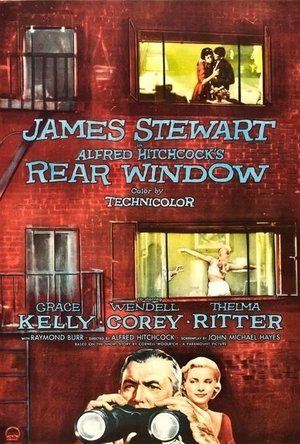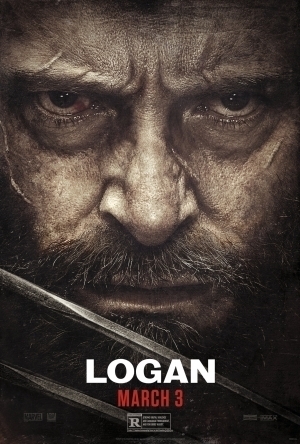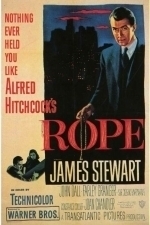Bob Mann (459 KP) rated Rear Window (1954) in Movies
Sep 29, 2021
rw-poster
In one pan around his small apartment, and without a word of dialogue required, Hitchcock deftly fills in all the back-story you need: Stewart plays ace photo-journalist L.B. Jefferies, laid up from jetting the world to worn-torn regions by a broken leg in a full-cast with only his courtyard view to entertain him. In sweltering summer temperatures all the apartments are open to the elements, so he can be well entertained by the menagerie before him: “Miss Torso”, the scantily-clad and frequently showering ballerina; a sculptress with an eye towards Henry Moore; a struggling composer (who has his clock wound by someone very familiar!); a newly-wedded bride threatening to wear out the groom; a salesman and his bed-ridden wife; a dog-loving and balcony-sleeping couple; and “Miss Lonelyhearts” – a hard-drinking spinster forced to create imaginary male dinner-guests.
Stewart plays his usual ‘Mr Ordinary’ watching perfectly ordinary goings on in a perfectly ordinary apartment block.
Or not. Jefferies is drawn to some odd-events in the apartment of the salesman (Raymond Burr, still 13 years before his career-defining role in TV’s “Ironside”). His rampant suspicions infect not only his cranky middle-aged physiotherapist Stella (Thelma Ritter) but also his perfect (“too perfect”) girlfriend, the fashion expert Lisa (Grace Kelly). Of course his police friend Doyle (Wendell Corey) is having none of it… there is no evidence of any crime being committed. And the “murdered” wife has been seen being put on a train by her husband, and is sending him letters from the countryside.
Is Jefferies just going stir-crazy? Or is there really something to it?
The set for this film is masterly. Although depicting a genuine location in New York’s Greenwich village the huge set was constructed on the Paramount lot in Hollywood, and you can just imagine the army of carpenters and artists building the multi-layered structure.
It’s one of the stars of the film, allowing for a wealth of detail to be populated: in the apartments; in the street behind; even in the cafe over the other side of the street. And it’s this detail that really makes what could be a highly static film come alive. There are a half dozen films-within-the-film going on at once, with Stewart’s character – and you as the fellow-voyeur – having a multi-pass to watch them all simultaneously.
And watch he does. As what could be perceived as a seriously pervy character – something he is called out on by Stella – Jeffries gets to see an eyeful in particular of the shapely and scantily-clad ballerina (Georgine Darcy, agent-less and only paid $350 for the role!). These scenes must have been deemed quite risque for the year of release.
Where the film rather falters is in the bickering romance between Stewart and Kelly. As a hot-blooded man, I will declare that even today Kelly’s first dream-like appearance (with Vaseline lightly coating the lens) is breathtaking. She’s just the ‘girl-next-door’: if you live next to a palace that is! And yet (with Kelly 21 years Stewart’s junior) she’s just “too perfect” for L.B. , who feels (against her protestations) that she’s ‘too girly’ to hack the life of a war photographer on the road. The mysogeny, common for the day, is gasp-making: “If a girl’s pretty enough, she just has to ‘be'” intones Stewart, to no howls of protest or throwing of saucepans! In fact Kelly is greatly encouraged: “Preview of coming attractions” purrs Kelly, flaunting what she has around the apartment in a negligee.
These scenes though are rather overlong and somewhat get in the way of the murder mystery plot-line. Things really start to warm up when a death occurs, to piercing screams in the night: “Which one of you did it?” shouts a woman to the neighbourhood, as everything – momentarily – stops. “WHICH ONE OF YOU DID IT?”. Given your emotional involvement in the ongoing voyeurism, it’s hard as a viewer not to feel discomforted…. (“well, it wasn’t me”…. shifts uneasily in the seat).
From then on, Hitchcock proceeds to pile on suspenseful jolt after jolt, with first Lisa and then L.B. placed in harms way. While the perpetrator may seem clueless and incompetent, as most murderers of passion probably are, the denouement is satisfying, with a great trial use of green-screen ‘falling’ that would be perfected by Hitchcock for “Vertigo” four years later.
What’s curious for such as classic is that there are a number of fluffed lines in the piece: with two notable ones by Stewart and Kelly. Hitchcock was the master of long and uninterrupted takes, but did he not believe in re-shooting scenes when such errors occurred? Most odd.
Although tighter and more claustrophobic that some of his better known films, this is a firm favourite of mine. If you’ve never seen it, its well worth you checking out.
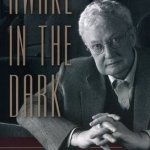
Awake in the Dark: The Best of Roger Ebert
Roger Ebert and David Bordwell
Book
Roger Ebert has been writing film reviews for the "Chicago Sun-Times" for over forty years. In fact,...

Sir Walter Raleigh
Book
Sir Walter Raleigh was truly the Renaissance man of Elizabethan England: soldier and diplomat...
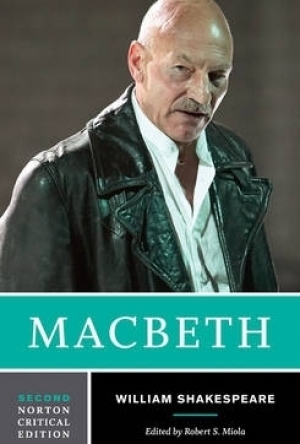
Macbeth
William Shakespeare and Robert S. Miola
Book
The Norton Critical Edition is again based on the First Folio (1623), the only authoritative text of...

Whole Earth Field Guide
Caroline Maniaque Benton and Meredith Gaglio
Book
The Whole Earth Catalog was a cultural touchstone of the 1960s and 1970s. The iconic cover image of...
LeftSideCut (3776 KP) rated Logan (2017) in Movies
Sep 20, 2019 (Updated Sep 20, 2019)
This is the third solo outing for Wolverine (following one garbage pile attempt, and one annoyingly average attempt), James Mangold really pulled it out of the bag for this one.
The characters are great - Hugh Jackman at the top of his game for his final performance as Logan. He's a grizzled and pain ridden man, in this bleak, mutantless future.
Patrick Stewart is also at his best here as Charles Xavier. The two of them are the beating heart of this movie.
We're introduced to Dafne Keen (playing a young X-23) who rounds out the small cast nicely.
As Logan fights a shadowy organization to keep her safe, the stakes have never been higher, and no one feels safe at any point - something that has never really been explored in the X-Men franchise.
Logan is a hard film to watch, it's bleak, its gritty, it's not particularly colourful (especially if you opt for the brilliant Noir version), and it's brutally violent in parts.
The set pieces are nasty in places, and sometimes pretty shocking, but it all aids the narrative here - the narrative that Wolverine is an ailing old man, who is struggling against all odds to do one last good deed, and protect the few people that still mean something to him.
It's an emotional and powerful film, that deserves all the praise bestowed upon it - amazing work from everyone involved .
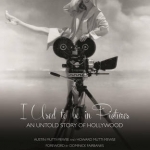
I Used to be in Pictures: An Untold Story of Hollywood
Austin Mutti-Mewse and Howard Mutti-Mewse
Book
I Used to be in Pictures is a collection of unpublished correspondence between English born...
Movie Metropolis (309 KP) rated Logan (2017) in Movies
Jun 10, 2019 (Updated Jun 10, 2019)
To this end, Hugh Jackman has finally decided to hang up his Adamantium claws after Logan, his ninth and apparently final outing as the grizzly hero. Are we third time lucky for his solo films?
James Mangold, director of The Wolverine, returns to the director’s chair and helms an at times brutal and uncompromising film speckled with the sort of emotional heft you’d find in the saddest rom-com’s.
In the near future, a weary Logan (Hugh Jackman) cares for an ailing Professor Charles Xavier (Patrick Stewart) in a hide out on the Mexican border accompanied by long-time acquaintance Caliban (Stephen Merchant). But Logan’s attempts to hide from the world and his legacy are upended when a young mutant, Laura, (Dafne Keen) arrives, being pursued by unspeakable dark forces.
In parts, Logan feels very much like a Western. The bleak, unforgiving Mexican landscape is a beautiful change from the dreary concrete jungles that blight the majority of superhero films these days and this is where Logan will either succeed or fail. It doesn’t feel like a superhero film, despite its faithfulness to the Old Man Logan comics.
Much like a metaphor for the genre itself, Logan has grown weary of the world and it is a testament to Hugh Jackman’s acting capabilities that he is able to add yet another dimension to a character that has been a cinema staple since the Millennium. Patrick Stewart is also on top form showing a vulnerable side to the world’s smartest mutant. Newcomer, Dafne Keen is also exceptional despite her limited dialogue.
Heartfelt scenes in which the oddball family share dinner with kind strangers are strikingly juxtaposed with sequences of sheer brutality. If you thought Deadpool was bloody, you haven’t seen anything yet. And for all the violence, Logan is the most poignant film in the entire X-Men canon, wearing its 15 certification proudly when it needs to, but not shying away from sections of quiet contemplation.
Negatives? Well, in spite of its gargantuan length, the ending feels a little tacked on and rushed – something a lot of modern blockbusters seem to feel is necessary at the moment and the final 30 minutes are a slight anti-climax in comparison to what preceded it, but on the whole, this final outing for Hugh Jackman proves a fitting one. Third time’s a charm!
https://moviemetropolis.net/2017/03/03/third-time-lucky-logan-review/
BankofMarquis (1832 KP) rated Rope (1948) in Movies
Nov 15, 2018
And, darn it all, if he doesn't pull it off.
The film starts off with a murder, we see two young men (John Dall and Farley Granger) strangling their "inferior" friend. They then decide to hold a dinner party to see if anyone can tell that they have committed murder. Included in this party is the dead friend's girlfriend (Joan Chandler), his father (Sir Cedrick Hardwicke) and their old school teacher (James Stewart).
The fun of this film isn't "will they get caught", it's "how will they get caught - and by who". The cast is wonderful (especially Hardwicke) but they all take a back seat to the absolute stellar performance of Stewart who begins to piece together that something is amiss and turns the tide on the two murderers.
The real star of this film is Director HItchock and his camera. Since he decided to make this in one long take, it took a master of organization and logistics to pull this off, having stagehands move furniture and walls out of the way (and back in again) as the camera moved around. In 1948, a camera could only hold 10 minutes worth of film, so the "one long take" aspect of this is a trick, as it is really 8 takes with strategic timing of camera movements behind walls and backs to give the illusion of seamlessness.
The interesting thing of this "trick" is that you are totally at the control of what Hitchock wants you to see (and not see). There is a scene about 1/2 way through the film that completely ignores the action and the people in the scene and focuses on the trunk the body is in. It is a masterwork, and the tension of keeping your focus there throughout the course of this part of the film is scary, tense and mesmerizing.
One last thing, Hitchock makes a cameo in every one of his films. Try to tell where Hitch is in this film (and, no, it is not as someone walking by the apartment at the beginning of the movie).
Not one of Hitchock's best, plotwise, but one of his best, camera-wise. Well worth checking out.
Letter Grade A-
8 (out of 10) stars and you can take that to the Bank (ofMarquis)

Scottish Gold
Neil D. L. Clark, Alison Sheridan and Donal Bateson
Book
Gold has been an important part of Scottish heritage for millennia and a new mine will shortly open...
